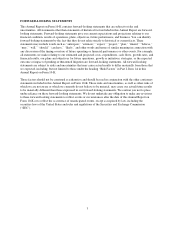Express 2011 Annual Report Download - page 21
Download and view the complete annual report
Please find page 21 of the 2011 Express annual report below. You can navigate through the pages in the report by either clicking on the pages listed below, or by using the keyword search tool below to find specific information within the annual report.
managers in the field, approximately 1,600 serve as store managers or co-managers, and approximately 16,000
are sales associates located in our stores. None of our employees are represented by a union, and we have had no
labor-related work stoppages. We believe our relations with our employees are good.
Seasonality
Our business is seasonal and, historically, we have realized a higher portion of our net sales and net income in the
third and fourth quarters due primarily to early Fall selling patterns as well as the impact of the holiday season. In
2011, approximately 56% of our net sales were generated in the Fall season (third and fourth quarters), while
approximately 44% were generated in the Spring season (first and second quarters). Cash needs are typically
higher in the first and third quarters due to inventory-related working capital requirements for early Fall and
holiday selling periods. Our business is also subject, at certain times, to calendar shifts, which may occur during
key selling periods close to holidays such as Easter, Thanksgiving, and Christmas, and regional fluctuations for
events such as sales tax holidays.
Available Information
We make available, free of charge, on our website, www.express.com, copies of our annual reports on Form
10-K, quarterly reports on Form 10-Q, current reports on Form 8-K, and all amendments to these reports filed or
furnished pursuant to Section 13(a) or 15(d) of the Securities Exchange Act of 1934, as amended (the “Exchange
Act of 1934”), as soon as reasonably practicable after filing such material electronically with, or otherwise
furnishing it to, the SEC. The SEC maintains a website that contains electronic filings at www.sec.gov. In
addition, the public may read and copy any materials we file with the SEC at the SEC’s Public Reference Room
at 100 F Street, N.E., Washington, D.C. 20549. The public may obtain information on the operation of the Public
Reference Room by calling the SEC at 1-800-SEC-0330. The reference to our website address does not constitute
incorporation by reference of the information contained on the website. Additionally, the information contained
on our website is not part of this Annual Report on Form 10-K.
ITEM 1A. RISK FACTORS.
Our business faces a number of risks. The risks described below are the items of most concern to us, however
these are not all of the risks we face. Additional risks and uncertainties not presently known to us or that we
currently consider immaterial may also impair our business operations.
RISK FACTORS
Our business is sensitive to consumer spending and general economic conditions, and a continued or further
economic slowdown could adversely affect our financial performance.
Consumer purchases of discretionary retail items, including our products, generally decline during recessionary
periods and other periods where disposable income is adversely affected. Our performance is subject to factors
that affect domestic and worldwide economic conditions, including employment, consumer debt, reductions in
net worth, residential real estate and mortgage markets, taxation, fuel and energy prices, interest rates, consumer
confidence, value of the United States dollar versus foreign currencies, and other macroeconomic factors. A
deterioration in economic conditions or increasing unemployment levels may reduce the level of consumer
spending and inhibit consumers’ use of credit, which may adversely affect our revenues and profits. In
recessionary periods, we may have to increase the number of promotional sales or otherwise dispose of inventory
for which we have previously paid to manufacture, which could adversely affect our profitability. Our financial
performance is particularly susceptible to economic and other conditions in regions or states where we have a
significant number of stores. A deterioration of economic conditions or slowdown in the economy could
adversely affect shopping center traffic and new shopping center development and could materially adversely
affect us.
13
























